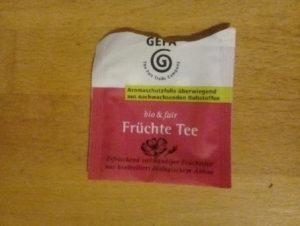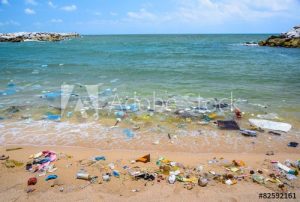In May of 2018, the European Commission proposed the introduction of a new set of rules in order to reduce the number of single-plastic items that are produced in the region. The reason behind the initiative is that, according to their press release on the subject, the 10-target single-use plastic (SUP) items account for the 70% of the marine litter on Europe. The rules are measured to specific items, for some, like plastic cotton buds, cutlery, plates, straws, drink stirrers and sticks for balloons, the EC proposed a ban given the fact that there are alternatives already in place. For others, like plastic containers, it would entail a reduction in the manufacture process. (European Commission, 2018)
Plastic consumption -and therefore, waste- is a problem that has been gaining the attention of some governments on the last decades. On one hand, plastic production takes up to 4% of the global oil production -and let’s not forget that burning of fossil fuels is the primary method of greenhouse gas emission to the atmosphere, which in turn is the main reason for anthropogenic climate change. And on the other, plastic pollution, according to the EPA, in 2016 approximately 60% to 80% of marine debris is estimated to be comprised of plastics. (U.S. Environmental Protection Agency, 2016) This amount of plastic in the oceans impact directly on the marine fauna and flora and it has two main consequences for human survival: the contamination of the food and the acidification of oceans.
Governments and supranational organizations worldwide are finally accepting the facts that science had been exposing for some time now, however, action has not been as diligent and expedient as one might think despite the sheer danger that crossing the threshold of an increase of 2 ºC on the temperature poses for the survival of humankind.
This situation has prompted many people to consider what they can do and if there could be a way to influence political action through individual action. After all, consumer patterns heavily influence markets and therefore, the economy of countries, and a population of engaged and conscientious voters would make politicians in democratic societies pay attention. Following this line of thought, through the years, the zero-waste –and included in it, the zero-plastic– movement was born, and it was our inspiration for a self-experiment through which we could determine if and how individual action can have a significant impact on politics, taking the perspective of prefiguration. We asked ourselves ‘how and through which mechanisms could Zero Plastic as a prefigurative social movement bring about new and alternative consumption patterns among society?’
The following essay will outline the answer to the aforementioned research question, obtained by the making of the self-experiment. First, we will discuss whether zero-plastic (and more broadly, zero-waste) can be considered a social movement, then what is -if there is any- the political content in this social movement and finally, we will present the self-experiment through several entries of a follow-up research diary.
Why is it going zero plastic, political?
The first theoretical hurdle presented when we formulated the research question in the self-experiment was whether the issue of plastic waste was susceptible of having enough engaged individuals to spur social change. On one side, it should be clear why the issue of plastic waste is, aside from a matter of environmental urgency, a political topic. Industries interested in profiting from the huge reach of plastic manufacture resist regulations and even move forward to lobby governments against them.
In 2017, following the plastic bag ban in the state of Michigan, in the US, lobby disclosures uncovered a bill to prevent communities from regulating this item “A review of lobbying disclosure records from several Midwestern states reveals that a new Michigan law banning communities from enacting regulations on plastic bags may be part of a larger special interests campaign by plastic manufacturers to keep their products on shelves and in grocery stores” (De Novato, 2017)
In 2016, the UK reduced the target for plastic recycling from 57% to 49%, under the justification of ‘lessening the burden on business. According to The Independent: “Greenpeace found that it was not small businesses but the British Plastics Federation (BPF), the leading trade association for the plastic industry, which had piled the pressure on the Government” (Rodionova, 2017)
And more recently, in 2018, after the EC statement on SUP, the Corporate Europe Observatory, published an extensive report on the state of the lobbying being pushed forward by different actors in the plastic industry. “We know that when the Parliament and Council discussed the plastics bag ban a few years ago, they were subjected to serious industry lobbying on the topic, with lobbyists joining forces with the MEPs and member states unwilling to take action. It is likely that the industry, including producers of single-use plastic products, are already gearing up for a similar fight” (Corporate Europe Observatory, 2018)
But why are these facts relevant for a prefigurative politics?
According to Wini Breines, prefiguration is concerned with the attempt to create on a small scale, the world one envisions, this means that it [prefiguration] is a performative act. (Breines, 1980) It takes distance from other kinds of social movements in that, it is not protesting or reclaiming, but performing an action that establishes a connection between utopia and reality, the future and the present. And this notion of a future ‘not-yet-here’ naturally must come from an individual concern -that might be social, political or economic- that prompts individual action without waiting for governmental intervention or another organization’s instruction.
Still, isolated and self-servient actions can’t be considered the actions of a social movement, that is why a significant portion of experts, class zero waste and zero plastic initiatives within the scope of lifestyle choices as separate from the notion of social movements. Hänfler et all, say that “Movements feature collective action, preferences for social change, (…)” while “Lifestyles encompass people’s everyday practices, tastes, consumption habits, (…) – one’s ‘individuality, self-expression, and stylistic self-consciousness” (Hänfler, Johnson and Jones, 2012). However, we agree with the authors in that there is an intersection between private action and political intention and it falls on the realm of prefiguration. Mario Diani puts forward a definition of what a social movement is, in his article ‘The concept of a social movement’; he defines it as “a network of informal interactions, between a plurality of individuals, groups and/or organizations, engaged in a political or cultural conflict, on the basis of a shared collective identity” (Diani, 1992). Under this conceptualization, a social movement then has elements that must be met like collective action that does not depend on hierarchical organization, shared beliefs and the intention to enact social change. We see that this definition doesn’t exclude the elements above-mentioned, that constitute a lifestyle. In fact, we would say that the elements on both definitions can be complimentary.
What we are seeing a shift in the paradigm of social movements within the scope of traditional politics, or as Hänfler calls it, contentious politics. This shift answers the growing public awareness of people who believe that their day-to-day decisions have a significant impact on society, and that are eager to make statements by changing their lifestyles accordingly and showing with personal examples how societies could be, in other words, prefiguring. Following this line of thought, we see prefigurative politics, as closely connected with lifestyle movements in the sense that LM use forms of prefiguration and PP take elements of what constitutes a lifestyle. Furthermore, says Hänfler, “Engagement in LMs reflects a broader shift in politics as ‘personal identity is replacing collective identity as the basis for contemporary political engagement’” (Hänfler, Johnson and Jones, 2012).
To bring our key argument, we wondered what could be considered the political aim or ‘agenda’ of this social movement. An analytical essay on the value and impact of the zero-waste movement in Denmark, connects it not only to Haenfler’s Lifestyle Movements, but also to Gauntlett’s ‘personal is political’ approach and the so-called ‘do-it-yourself mentality. “(…) with the rise of the zero-waste movement a bigger will from parts of the public becomes present, which puts demands on businesses and politicians to do something about the plastic and waste issue because many of the people approaching the zero-waste lifestyle seems to support that change needs to happen on multiple levels” (Pedersen, 2017). The article gathers empirical data through interviews made to members of the movement to demonstrate how initially personal interests turned into the need to create communities -and here social media plays a decisive role- and create the demand for the market and the institutions to start offering more alternatives to further their new choice of lifestyle.
It is safe to say that, as of now, the zero-plastic -within the zero-waste- has grown enough to be acknowledged as a social movement, and even more, an example of prefigurative politics: They have a political aim, a community and advocates around the globe who are living the change the want to have in society. Even more, they are getting attention from political parties:
- Australia’s capital adopted a No Waste by 2010 goal and plan in 1996. The plan envisions a waste-free city by 2010, with its two landfills replaced by ‚Resource Recovery Estates. (Connett and Sheehan, 2001)
- Del Norte County is the first county in the United States to guide its solid waste strategy with a comprehensive Zero Waste plan, which it adopted in 2000. Officials expect the plan to ease the conversion from a timber-oriented economy to a new, sustainable economy using local resources currently being wasted. (Connett and Sheehan, 2001)
Discovering through self-transformation
Going through a self-experiment for four weeks allowed us to bridge the gap between the theory discussed previously and the praxis, and it contributed greatly to answer our research question. The self-transformation aspect of a lifestyle change, united with the intention of planting a seed of social transformation. We designed the process with the idea to refrain from buying products that contained plastic in all its processing forms, including plastic packaging, microplastic and other plastic derivates. Also, with the understanding that changing consumption patterns was not something done overnight, we decided to exclude a ban on utilizing products that could be used for long periods of time and that we already possessed (e.g. Tupperware) and products that were made of recycled plastic. For my own research purposes, I made a diary of relevant situations throughout the experience, which led me to search for and find information to become more creative in my self-transformation process, prompted me to engage more with the practices, the advocacy and finally, joining the movement in a ‘step-by-step’ format.
Diary entries (10.06.2018 – 16.06.2018)
We started the self-experiment and in my first outing to the store for grocery shopping (11.06) I was able to stick to the objective, although truth to be told, I couldn’t buy all the things I had planned. My buying practices changed as it follows:
- I forwent buying sliced bread in plastic packaging and instead bought freshly baked bread packed in a paper bag.
- I didn’t grab a plastic bag to put fruits on -apples and bananas- and I instead put them directly on the fabric bag I brought.
- I refrained from buying cheese, snacks or any plastic bottled liquid
- I bought products in cans and crystal bottles (corn, beans, apfelmus)
On 12.06, I went to the cafeteria after class and on a reflex, I bought tea. The cup was carton, but the packaging of the tea bag was plastic. – An interesting element that came to the self-reflection is the automaticity in consumer behavior – in other words, there are certain habits or practices in our buying patterns that are not subjected to ponderation. We buy on reflex and don’t analyze what it is exactly we are consuming.
On a later outing (15.06), I was supposed to bring some snacks to a party. I had partial success. I bought beer in cans, chips in a carton cylinder, and corn for popcorn. The plastics I consumed were the cap on the chips and the corn was on a plastic package. There were no other alternatives for these. I was sick on 16.06, and so I needed to buy medicine at the pharmacy, and I managed to find an alternative in glass bottle inside a carton box, the only plastic was the cap on the bottle but the medicine will last likely a few months so it’s not a one-time consumption.
(17.06.2018 – 23.06.2018)
On 18.06 we had a barbeque. I managed to stick to the objective with partial success. I brought my own glass cup, wooden utensils, and paper plates. I brought a potato salad in a glass container, but to make it I had to buy nuts in plastic packaging and in the barbeque, I had to use plastic cups for some of the activities. On 20.06 I went to buy some necessities for my room. I bought hangers, a hairbrush, a p illow and sheets. I decided to buy wooden hangers and hairbrush even at a higher cost, but the pillow and sheets were unavoidable plastic packed.
illow and sheets. I decided to buy wooden hangers and hairbrush even at a higher cost, but the pillow and sheets were unavoidable plastic packed.
Also, I wanted to buy a snack so I went through the whole store until a found a carton packed one. However, when I opened it, I found out a double plastic packaging – a plastic tray covered by a plastic paper sheet-.
Conclusion
Going zero plastic for a month led us to discover that this practice, ascribed to the zero waste movement, that started as a valid concern over the state of the oceans, the problem of toxic landfills, the quality of seafood and other matters, has grown into a movement that takes elements of prefiguration in its aim to generate social change, that, in turn, spurs political and economic action from governments in the path of policies, regulations and laws. The practice hosts both types of people, those whose motivation stays personal, and those who believe in acting as a shout out for transformation and advocate through different media, dedicate their time to educate others and raise awareness, and challenge existing power structures that perpetuate on the old practices.
From an individual perspective, joining the movement and thus, engaging with the community through social media and starting my own brand of advocacy with family and friends, has a primary motivation in initiating and encouraging social change. Reducing plastic consumption in a significant way is not only advisable, but it can be considered an ethical imperative. And as sustainability is a condition for the survival of human species, it has the very specific quality of being a matter of individual responsibility.
However, the self-experiment also taught us that perhaps the greatest challenge of living a less-ridden plastic, or even a zero-plastic, lifestyle comes with the number of the alternatives available, the pricing and the regulations in place made by governments and supranational institutions. Social change can be achieved by enough individuals performing acts of prefiguration, but in order to successfully ‘prefigure’ it is necessary to have the tools for it, and when the tools are material elements, aid is needed from a macro perspective, the legislation.
A contribution from Leslye Dias
References
- Breines, W. (1980). Community and Organization: The New Left and Michels‘ „Iron Law.“ Social Problems, 27(4), pp.419-429.
- Connett, P. and Sheehan, B. (2001). A Citizen’s Agenda for Zero Waste. [ebook] GrassRoots Recycling Network., pp.1 – 28. Available at: http://archive.grrn.org/zerowaste/community/activist/citizens_agenda_2_read.pdf [Accessed 22 Aug. 2018].
- Corporate Europe Observatory (2018). Plastic promises: Industry seeking to avoid binding regulations. The power of lobbies. [online] Available at: https://corporateeurope.org/power-lobbies/2018/05/plastic-promises [Accessed 18 Aug. 2018].
- Corporate Europe Observatory (2018). Plastic lobbying. [image] Available at: https://corporateeurope.org/sites/default/files/plastic_web-lobby.png [Accessed 18 Aug. 2018].
- De Novato, A. (2017). Plastic industry lobbyists prevent communities from reducing pollution. Science around Michigan. [online] Available at: https://www.sciencemi.org/politics/plastic-lobbyists-prevent-reducing-pollution/ [Accessed 22 Aug. 2018].
- Diani, M. (1992). The Concept of Social Movement. The Sociological Review, 40(1), pp.1-25.
- European Commission (2018). Single-use plastics: New EU rules to reduce marine litter. [online] Available at: http://europa.eu/rapid/press-release_IP-18-3927_en.htm [Accessed 22 Aug. 2018].
- Hänfler, R., Johnson, B. and Jones, E. (2012). Lifestyle Movements: Exploring the Intersection of Lifestyle and Social Movements.
- Pedersen, M. (2017). THE ZERO WASTE MOVEMENT: A case study of mundane climate change activism in Denmark. pp.1 – 50.
- Rodionova, Z. (2017). Government cut recycling targets after lobbying from plastics industry. The Independent. [online] Available at: https://www.independent.co.uk/news/business/news/government-recycling-targets-cut-pressure-plastics-lobbying-industry-a7585501.html [Accessed 18 Aug. 2018].
- S. Environmental Protection Agency (2016). A Summary of Literature on the Chemical Toxicity of Plastics Pollution to Aquatic Life and Aquatic-Dependent Wildlife. [online] Available at: https://www.epa.gov/wqc/aquatic-life-ambient-waterquality-criteria. [Accessed 20 Aug. 2018].


